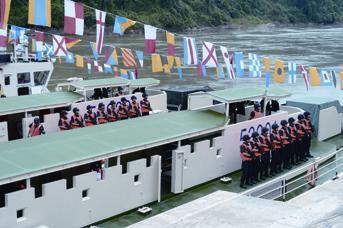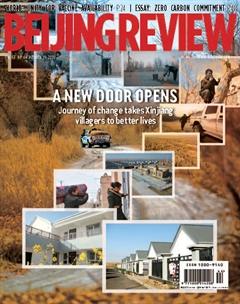Stop Playing The Water Card
By Guo Yanjun

The Lancang-Mekong River flows through China, Laos, Myanmar, Thailand, Cambodia and Viet Nam, known as Lancang in China and Mekong elsewhere.
The U.S. began to meddle over the river in 2009, when it launched the Lower Mekong Initiative with Cambodia, Laos, Thailand and Viet Nam, attempting to curb Chinas growing influence in the region. The initiative ran in line with the Rebalance to Asia and the Pacific strategy proposed by then U.S. President Barack Obama, with the aim to modernize and strengthen U.S. alliances.
In its early days, the initiative prioritized capacity building in environmental protection, education, public health and infrastructure. Although then U.S. Secretary of State Hillary Clinton unfoundedly criticized China for its dams on the upper reaches of the river, no substantial cooperation on water resources was conducted.
In 2012, Myanmar joined the initiative. The areas of cooperation were then identified as the environment and water, health, agriculture, connectivity, education and energy security. A series of projects such as SERVIRMekong, which would use satellite images and geospatial technologies to help governments and others tackle climate challenges, were proposed.
On September 14, the U.S. announced the launch of the Mekong-U.S. partnership for sustained growth of its Mekong partners and pledged to increase investment and cooperation. At the same time, it continued to hype environmental and resources issues and tarnish Chinas efforts in the area. It accused China of “manipulating” the LancangMekong River flows, disregarding the fact that China has been providing hydrological data for the Mekong River Commission(MRC) and downstream countries for 18 consecutive years and helping them formulate plans for flood prevention and drought mitigation.
The renewed attempt is an example of the current U.S. strategy toward China. Compared with the policies of the Obama administration, it is more aggressive.
Chinas efforts
The management of trans-boundary rivers has always been a complex and sensitive issue. Some scholars think this can lead to water wars among the river-sharing countries. The Lancang-Mekong flows through six countries for 4,909 km, so its development and management remain particularly complex. Thanks to their joint efforts, no major water-related conflicts have emerged in the region.
China has always taken an active part in multilateral cooperation with regional countries. It joined the Greater Mekong Subregion Economic Cooperation mechanism in 1992. In 1996, it became a dialogue partner of the MRC, an inter-governmental river basin organization initiated by Cambodia, Laos, Thailand and Viet Nam. It signed the first hydrological datasharing agreement with the commission in 2002, promising to share data about daily river flows and rainfall data upstream during the rainy season.
At the 17th leaders meeting between China and the Association of Southeast Asian Nations (ASEAN) in 2014, in response to Thailands proposal of strengthening sustainable development of the Lancang-Mekong subregion, China initiated a cooperation mechanism, which gained general support.
Over the past five years since its establishment, the Lancang-Mekong Cooperation (LMC) mechanism has been improved under the principles of consensus, equality, voluntarism, mutual consultation and coordination, common contribution and shared benefits. It has made progress in practical cooperation in many areas including sharing water resources, and has become an effective platform for exchanges between China and other Lancang-Mekong countries.

Since the mechanism was launched, China has sent emergency notifications on major changes in the outflow of the Jinghong Hydropower Plant on the Lancang-Mekong several times. The project is located in the southwestern province of Yunnan, which borders Laos, Myanmar and Viet Nam.
China has always regarded ASEAN countries as a priority in its neighborhood diplomacy. The Lancang-Mekong countries are linked by mountains and rivers, and enjoy profound friendship and inherent geographical advantages in cooperation.
In 2018, Chinas total trade with other Lancang-Mekong countries exceeded $260 billion, and Chinas investment in them exceeded$45 billion. They have become important trading and investment partners of China. Enhanced Lancang-Mekong cooperation and friendship has become an important part of the strategic partnership between China and ASEAN that also consists of Brunei, Malaysia, Indonesia, Singapore and the Philippines.
Reckless accusations
The U.S. has been stirring up issues between China and some ASEAN countries over the South China Sea, which has undermined regional peace and stability.
Water resources cooperation, a priority area in Lancang-Mekong cooperation, has made encouraging progress in recent years, which has also made it a thorn in the side of the U.S.
U.S. Assistant Secretary of State for East Asian and Pacific Affairs David Stilwell recently cited a report claiming “China has been manipulating the water flows along the Mekong for 25 years, with the greatest disruption in natural flows coinciding with major dam construction and operation.”
However, experts have found that after Chinas cascade reservoirs on the river were put into use, the flow of water in the dry season increased by 20 percent compared to the pre-dam days. The latest report by the MRC released in August also acknowledged that the reservoirs function of storing water in the flood season for use in the dry season has helped maintain a steady flow of the waters.
At the Third Lancang-Mekong Cooperation Leaders Meeting held online in August, Chinese Premier Li Keqiang announced that China will share annual hydrological information on the river with other regional countries, which will elevate their cooperation.
But the U.S. attempted to make an issue out of it again by asking China to share its water data, including dam operation data, saying it should be shared through MRC instead of other platforms.
The U.S. strategy is to use the water issue to create a hot spot, sow discord between regional countries, and sabotage the Lancang-Mekong cooperation. Washington has also continued to demonize and stigmatize the Communist Party of China and the Chinese Government, portraying China as a hydro-hegemonic country. But all its attempts have ended in vain.
China desires common development and is willing to work with other Lancang-Mekong countries achieve development, narrow the gap within ASEAN and help build the ASEAN community.
A seamless connection between the LMC mechanism and the New International LandSea Trade Corridor, a trade and logistics passage jointly built by provincial-level divisions in west China and ASEAN countries, will promote the development of its central and western regions.
The Lancang-Mekong closely links the futures of the six littoral countries and winwin cooperation is their common choice, which will not be interrupted by any political manipulation.

